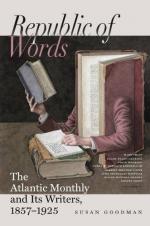After crossing the river, our path, with the perversity of all Spanish roads, instead of following up the valley of the stream, diverged widely to the right through a cluster or knot of hills, in which we were involved until we reached a rapid stream called Rio Guanupalapa, flowing through a narrow gorge, over a wild mass of stones and boulders. Here we breakfasted, picturesquely enough, and, resuming our course, soon emerged from the hilly labyrinth on a series of terraces, falling off like steps to the river on our left. They had been burned over, and the young grass was sprouting up, under the freshening influence of the early rain, in a carpet of translucent green. At a distance of four leagues from San Juan, after descending from terrace to terrace, we again reached the river, now flowing through a valley three hundred yards broad, and about fifty feet below the general level of the adjacent plateau. Here we found another fork in the stream: the principal body of water descending, as before, from the right, and called Rio Rancho Grande; the smaller stream, on the left, bearing the name of Rio Chaguiton; and the two forming the Rio Goascoran. Half a mile beyond the ford is a collection of three or four huts, called Rancho Grande. Here we stopped to determine our position. We were now at the foot of the “divide,” and close to the pass, if such existed, of which we were in search. Immediately in front rose a high peak, destitute of trees, which the people called El Volcan. It had deep breaks or valleys on either side, evidently those of the streams to which I have alluded. Outside of these, the mountains, six or eight thousand feet in height, swept round in a majestic curve. Were there, then, two passes through the Cordilleras, separated by the conical peak of El Volcan? or did the great valley of the Goascoran divide here, only to waste itself away in narrow gorges, leaving a summit too high to be traversed except by mountain mules?
Strange to say, the occupants of the huts at Rancho Grande could give us no information on these points, but to all our inquiries only answered, "Quien sabe?" (Who knows?)—and pointed out to us the line of the mule-path, winding over the intervening hills and along the flank of El Volcan. Up to this time we had had comparatively small experience, and did not quite understand, what we afterwards came to know too well, that a Spanish road is perfect only when it runs over the highest and roughest ground that by any possibility may be selected between two given points.
We did not waste much time with the people of Rancho Grande, but urged on our mules as rapidly as possible. Turning abruptly to the right and leaving the plateau behind us, we advanced straight up the high ridge intervening between the two valleys, and thence in a zigzag course to the foot of El Volcan, a mass of igneous rock, protruded through the horizontal sandstone strata,—the gradual recession of which




